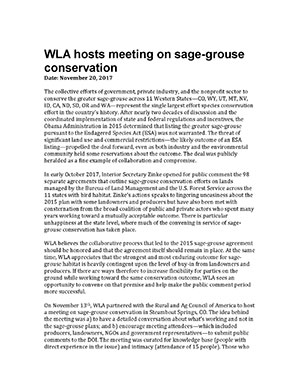WLA hosts meeting on sage-grouse conservation
The collective efforts of government, private industry, and the nonprofit sector to conserve the greater sage-grouse across 11 Western States—CO, WY, UT, MT, NV, ID, CA, ND, SD, OR and WA—represent the single largest effort species conservation effort in the country’s history. After nearly two decades of discussion and the coordinated implementation of state and federal regulations and incentives, the Obama Administration in 2015 determined that listing the greater sage-grouse pursuant to the Endangered Species Act (ESA) was not warranted. The threat of significant land use and commercial restrictions—the likely outcome of an ESA listing—propelled the deal forward, even as both industry and the environmental community held some reservations about the outcome. The deal was publicly heralded as a fine example of collaboration and compromise.
In early October 2017, Interior Secretary Zinke opened for public comment the 98 separate agreements that outline sage-grouse conservation efforts on lands managed by the Bureau of Land Management and the U.S. Forest Service across the 11 states with bird habitat. Zinke’s actions speaks to lingering uneasiness about the 2015 plan with some landowners and producers but have also been met with consternation from the broad coalition of public and private actors who spent many years working toward a mutually acceptable outcome. There is particular unhappiness at the state level, where much of the convening in service of sage-grouse conservation has taken place.
WLA believes the collaborative process that led to the 2015 sage-grouse agreement should be honored and that the agreement itself should remain in place. At the same time, WLA appreciates that the strongest and most enduring outcome for sage-grouse habitat is heavily contingent upon the level of buy-in from landowners and producers. If there are ways therefore to increase flexibility for parties on the ground while working toward the same conservation outcome, WLA sees an opportunity to convene on that premise and help make the public comment period more successful.
On November 13th, WLA partnered with the Rural and Ag Council of America to host a meeting on sage-grouse conservation in Steamboat Springs, CO. The idea behind the meeting was a) to have a detailed conversation about what’s working and not in the sage-grouse plans; and b) encourage meeting attendees—which included producers, landowners, NGOs and government representatives—to submit public comments to the DOI. The meeting was curated for knowledge base (people with direct experience in the issue) and intimacy (attendance of 15 people). Those who attended the meeting will receive a discussion summary and be given basic guidance for how they can submit comments to the DOI.
After the November 13th meeting, WLA was on the ground in Washington, D.C. with a coalition of western agriculture and conservation organizations to discuss the future of sage-grouse. The group targeted its advocacy to senators and congressmen who represent districts and states with sage-grouse habitat and also met with high-level officials at DOI, BLM and USDA responsible for implementing the federal government’s sage-grouse conservation activities.
Join WLA to stay up to date on the most important news and policy for land stewards.
Become a member for free today and we will send you the news and policy developments critical to the economic and ecological health of working lands.
WLA works on behalf of landowners and practitioners throughout the West. We will never share your contact information with anyone.
